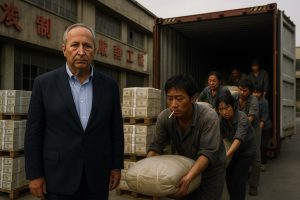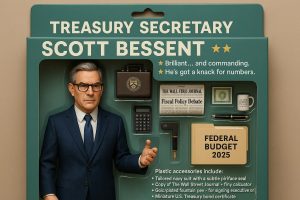As the U.S.-China trade war escalates, President Donald Trump’s tariffs—reaching up to 100% on Chinese imports with proposed hikes to 200%—have inadvertently illuminated China’s extraordinary ascent as the global hub of innovation, manufacturing, and infrastructure. Far from retreating, China has countered with a bold strategy of openness, leveraging its technological breakthroughs, world-class infrastructure, and global engagement to redefine its role in the world economy. From disclosing the Chinese origins of luxury brands to expanding visa-free travel, dominating high-speed rail, leading in electric vehicles (EVs), and pioneering artificial intelligence (AI) and renewable energy, China is outpacing a United States mired in protectionist policies, crumbling infrastructure, and bans on competition like TikTok. This article delves into China’s forward-thinking vision, contrasts it with U.S. efforts to stifle innovation, and explains why China is not just the future but the present of global economic and technological leadership.
The Trade War: China’s Openness vs. U.S. Protectionism
Escalating Tensions and Tariff Missteps
The U.S.-China trade war has reached a fever pitch, with Trump imposing tariffs of up to 100% on Chinese goods, including EVs and semiconductors, and proposing increases to 200% to protect American industries (Reuters, Trump Tariffs). China has retaliated with tariffs of up to 125% on U.S. products, but its broader strategy diverges sharply from U.S. protectionism. Instead of isolating itself, China is embracing openness, strengthening global ties, and showcasing its innovation to counter tariff pressures. This approach has turned Trump’s tariffs into an unintended spotlight on China’s capabilities, revealing a nation poised to lead the global economy.
China’s Strategic Openness
China’s response to the trade war is multifaceted, emphasizing integration and transparency. By revealing that many luxury brands—previously associated with European craftsmanship—are manufactured in China, the country is dismantling the “Made in China” stereotype, highlighting its advanced manufacturing prowess (SCMP, Luxury Brands). Additionally, China’s 240-hour visa-free transit policy for tourists from 54 countries has boosted tourism, with a 30% increase in foreign visitors in 2024, fostering economic and cultural exchange (Travel and Leisure Asia, Visa-Free Policy). China has also introduced tax rebates for foreign shoppers and signed trade agreements with ASEAN nations, reinforcing its role as a global economic leader (ASEAN Trade Agreements). These moves contrast sharply with U.S. policies that restrict trade and immigration, positioning China as a beacon of openness.
Technological Dominance: China’s Innovation Engine
TikTok Ban: Protectionism Stifling Competition
The U.S. effort to ban TikTok, owned by Chinese firm ByteDance, exemplifies protectionism masquerading as national security. While officials cite concerns about Chinese government access to U.S. user data—a worry shared across party lines—critics argue the ban is designed to shield American tech giants from Chinese competition (NYT, TikTok Ban). TikTok’s legal challenge contends that the ban, driven by Trump’s political motives, violates free speech and economic competition. A Forbes analysis suggests the ban reflects envy of China’s tech prowess rather than genuine security threats (Forbes, TikTok Ban). The ban’s timing, coinciding with U.S. tech firms’ struggles to match TikTok’s algorithmic innovation, underscores economic rivalry. By stifling TikTok, the U.S. risks isolating itself from global tech trends, inadvertently boosting Chinese platforms like RedNote.
Shanghai and RedNote: The Digital Future
Shanghai, China’s technological and financial epicenter, is a global symbol of innovation, epitomized by the rise of RedNote (Xiaohongshu). This social media platform, blending Instagram-like lifestyle content with e-commerce, has exploded in U.S. popularity, gaining 3 million daily active users in a single day in January 2025 as “TikTok refugees” sought alternatives (Reuters, RedNote Surge). RedNote’s curated content, from fashion to travel, and its seamless shopping integration have made it a cultural bridge, connecting American and Chinese users (Rolling Stone, RedNote). Headquartered in Shanghai, RedNote reflects the city’s futuristic blend of technology and culture, with smart city initiatives like 5G-enabled public services and AI-driven traffic systems reinforcing its avant-garde status (Smart Cities World, Shanghai).
AI and Tech Leadership
China’s technological dominance extends beyond social media to artificial intelligence and semiconductors. Companies like DeepSeek have developed AI models rivaling OpenAI’s ChatGPT, with the R-1 chatbot achieving comparable performance at a fraction of the cost (DeepSeek R-1). Despite U.S. restrictions on advanced chip exports, China has invested heavily in domestic semiconductor production, with firms like SMIC producing 7nm chips by 2024 (Bloomberg, China Chips). These advancements position China as a leader in the AI-driven economy, while U.S. bans on Chinese tech stifle collaborative innovation.
Infrastructure and Manufacturing: China’s Global Edge
High-Speed Rail: An Engineering Marvel
China’s high-speed rail (HSR) network, spanning over 48,000 km, is the world’s largest, accounting for two-thirds of global HSR mileage. Connecting major cities at speeds up to 350 km/h, it has transformed domestic travel and economic connectivity (China HSR). Since its first line in 2008, China has built 25,000 km of HSR in under a decade, a feat driven by centralized planning and $1 trillion in investments (World Bank, China HSR). The CR450 prototype, unveiled in 2024 with commercial speeds of 400 km/h, sets a new global standard (SCMP, CR450). Through the Belt and Road Initiative, China exports its rail expertise to over 20 countries, enhancing global connectivity (BRI Overview). In contrast, the U.S. lacks a national HSR system, with projects like California’s HSR delayed by decades and cost overruns (LA Times, California HSR).
Infrastructure Disparity: China’s Lead
China’s infrastructure dominance extends beyond rail to roads, bridges, and power grids. Investing 5.6% of GDP in transportation—versus the U.S.’s 0.5%—China has built 1.3 million km of highways and 177,000 km of expressways (FreightWaves, Infrastructure Gap). Its power grid is among the world’s most reliable, with urban outages rare, compared to the U.S., where 70% of the grid is over 25 years old, causing frequent blackouts (Salibra, China Infrastructure). The U.S. infrastructure, graded D+ by the American Society of Civil Engineers, suffers from 43% of roads in poor condition and 42,000 bridges at risk (ASCE Report). China’s $2.3 trillion annual infrastructure spending dwarfs the U.S.’s $1.2 trillion over five years, highlighting divergent priorities.
| Aspect | China | U.S. |
|---|---|---|
| High-Speed Rail | 48,000+ km, speeds up to 350 km/h, CR450 at 400 km/h | No national HSR, regional rail at 200 km/h max |
| Infrastructure Spending | 5.6% of GDP on transportation | 0.5% of GDP on transportation |
| Power Grid Reliability | Highly reliable, minimal urban outages | 70% of grid over 25 years old, frequent outages |
| Roads and Bridges | 1.3M km highways, 177,000 km expressways | 43% of roads in poor condition, 42,000 bridges at risk |
| Project Execution | Rapid, centralized planning | Slow, stalled by bureaucracy and funding |
This table underscores China’s infrastructure superiority, driven by massive investment and strategic vision, while the U.S. struggles with obsolescence.
Manufacturing Prowess
China’s manufacturing sector, producing 30% of global goods, remains unmatched. Its supply chain efficiency and $4.6 trillion in annual industrial output enable resilience against U.S. tariffs (World Bank, Manufacturing). From luxury goods to electronics, China’s factories leverage automation and AI to maintain quality and cost advantages. The U.S., with only 16% of global manufacturing, faces supply chain disruptions and higher costs due to tariffs (Brookings, U.S. Manufacturing). China’s ability to produce high-end products domestically, like 5G equipment and drones, solidifies its industrial dominance.
Electric Vehicles and Green Tech: China’s Sustainable Future
BYD and Chinese EVs: Overtaking Tesla
Chinese automakers, led by BYD, are redefining the EV market, challenging Tesla’s dominance with affordable, high-performing models. BYD’s Seal Premium ($58,798) outperforms the Tesla Model 3 ($61,900) in range (520 km vs. 438 km) and power, while the Atto 3 ($37,695) undercuts the Model Y ($44,990) (Carsales, BYD vs. Tesla). The Seal’s all-wheel-drive version accelerates from 0-62 mph in 3.9 seconds, rivaling Tesla’s top models (Sturgess, BYD Performance). BYD’s diverse lineup—spanning compact cars, SUVs, and luxury sedans—caters to global markets, with exports to 70 countries (Swansway, BYD vs. Tesla). China’s EV market, holding 37% of global sales in 2024, benefits from $100 billion in government subsidies and 500,000 charging stations (Bloomberg, China EVs). In contrast, U.S. EV options are limited, with Tesla’s high prices and GM’s slow rollout hampering competition (Economy Middle East, BYD).
| Model | BYD Seal Premium | Tesla Model 3 RWD |
|---|---|---|
| Price | $58,798 | $61,900 |
| 0-62 mph | 3.9 seconds (AWD) | 5.8 seconds |
| Range | 520 km | 438 km |
| Market Reach | 70 countries | Global, higher cost |
This table highlights BYD’s competitive edge, reflecting China’s EV leadership.
Renewable Energy Leadership
China’s dominance in green technology extends to solar and wind energy, producing 60% of global solar panels and 50% of wind turbines (IEA, Renewable Energy). With 430 GW of solar capacity and 400 GW of wind by 2024, China accounts for 40% of global renewable energy production, dwarfing the U.S.’s 140 GW combined (EIA, U.S. Renewables). China’s $546 billion investment in clean energy in 2024—five times the U.S.’s—drives its net-zero ambitions, positioning it as the leader in sustainable innovation (BloombergNEF, Clean Energy). The U.S., hampered by policy reversals and fossil fuel reliance, lags in the green transition.
U.S. Protectionism: A Recipe for Decline
Economic Costs of Tariffs and Bans
U.S. protectionist policies, including tariffs and the TikTok ban, aim to protect domestic industries but risk long-term decline. Tariffs have raised costs for U.S. consumers by $79 billion annually, with EV prices increasing 20% due to import duties (Peterson Institute, Tariff Costs). The TikTok ban, if enforced, could disrupt $24 billion in U.S. economic activity, driving users to Chinese platforms like RedNote and stifling tech innovation (Oxford Economics, TikTok Impact). These policies isolate the U.S. from global markets, while China’s openness fosters collaboration.
Innovation Stagnation
By banning Chinese tech and imposing tariffs, the U.S. discourages domestic innovation. The tech sector, reliant on global talent and supply chains, faces R&D setbacks, with U.S. AI investment ($67 billion in 2024) trailing China’s $103 billion (CB Insights, AI Investment). The U.S. EV market, dominated by Tesla, lacks the diversity of China’s 100+ EV brands, limiting consumer choice and innovation (Forbes, U.S. EV Market). Protectionism also deters foreign investment, with China attracting $189 billion in FDI in 2024 compared to the U.S.’s $132 billion (UNCTAD, FDI 2024).
Infrastructure and Competitiveness Lag
The U.S.’s infrastructure crisis—spending only 0.5% of GDP versus China’s 5.6%—undermines its competitiveness. With no national HSR, a failing grid, and delayed projects, the U.S. cannot match China’s connectivity or efficiency (ASCE Report). This lag raises logistics costs, with U.S. freight transport 30% more expensive than China’s, impacting global trade competitiveness (World Bank, Logistics). As China builds smart cities and green infrastructure, the U.S.’s inaction risks economic stagnation.
Why China Is the Future
China’s ascent as the innovation powerhouse of the future rests on four pillars: strategic openness, technological leadership, unmatched infrastructure, and sustainable innovation. Its openness—through visa-free policies, trade agreements, and transparency about manufacturing—builds global trust and economic ties. Technological advancements in AI, social media, and semiconductors position China at the forefront of the digital economy. Its infrastructure, from HSR to smart cities, ensures efficiency and connectivity, supporting domestic growth and global influence. In green tech, China’s EV and renewable energy dominance drives the sustainable future, aligning with global net-zero goals.
In contrast, U.S. protectionism—through tariffs, tech bans, and underinvestment—stifles innovation and isolates the nation. By banning TikTok, the U.S. limits access to global platforms, while tariffs raise costs and deter investment. The U.S.’s crumbling infrastructure and limited EV options reflect a failure to prioritize long-term competitiveness. As Shanghai emerges as a futuristic hub, BYD outpaces Tesla, and China’s AI and rail systems set global standards, the evidence is clear: China is not just weathering the trade war but reshaping the global order.
Conclusion: Embracing the Chinese Century
China’s response to Trump’s tariffs has been a masterclass in strategic resilience, transforming adversity into opportunity. By embracing openness, investing in infrastructure, and leading in technology and green innovation, China is not only the present but the future of global leadership. The rise of RedNote, the dominance of high-speed rail, the supremacy of BYD, and breakthroughs in AI and renewables underscore China’s unstoppable ascent. Meanwhile, the U.S.’s protectionist policies—banning competition, neglecting infrastructure, and stifling innovation—risk relegating it to the sidelines. As China’s vision reshapes global markets, the U.S. must abandon protectionism and embrace competition to avoid fading in the shadow of the Chinese century.








Be First to Comment